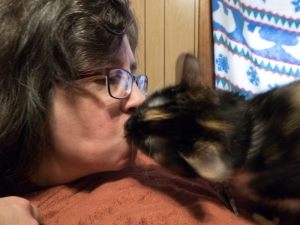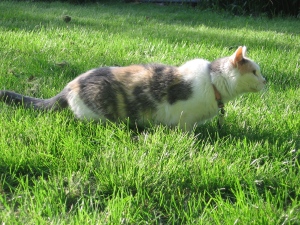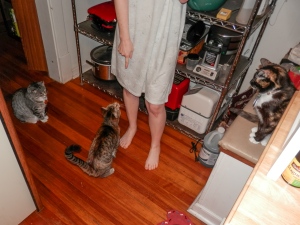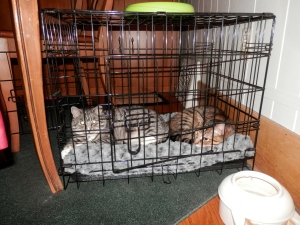When it comes to my experience with cats and food, God has a sense of humor. My first cat, a stray, proved finicky over food right from the start. In contrast, my second cat and a rescue, will eat pretty much anything I put in front of her and then growl to protect her food. To a certain extent, cat needs are pretty simple when it comes to food, amounting to a choice between dry, wet, raw, or a combination. Even so, there are facts to be aware of, and what follows is an elaboration of the aforementioned information based on my research and experience.
ESSENTIAL INGREDIENTS

Whether cats are fed dry, wet, or raw food, there are certain ingredients that all cat food must have. The first one I learned about when I became a cat owner in 2009 is taurine. The ingredient stood out to me, as it’s an essential ingredient of cat foods but not dog foods. Natural Pet talks about how back in the 1970’s, thousands of cats were mysteriously dying due to a form of heart failure called dilated cardiomyopathy. At the same time, there were reports of cats going blind that were often associated with cats being fed dog food. Finally, in the late 1980s, the problem was traced to the deficiency of a basic amino acid called taurine.
Animals can manufacture many but not all of the essential 22 amino acids, or basic building blocks of protein, in their liver. Those that animals can’t manufacture in their own bodies must be obtained in the diet. For cats, taurine is one of those amino acids. Taurine is found primarily in muscle meat. As noted above, the lack of it causes serious heart and eye diseases in cats. Today reports Los Angeles Times, all commercial cat foods are supplemented with taurine. However, if you feed your cat a vegetarian diet, you might need to give him a taurine supplement.
Although all commercial cat foods today are supplemented with taurine, not all cat foods are created equal. For that reason, you should always check the label. What specifically should you look for? To ensure that your cat gets enough good sources of protein, check the first three ingredients on the label. Pet food labels list ingredients in order of the weight of the ingredient, starting with the heaviest. If beef, chicken, fish, or other meats top the list, the food should contain an appropriate level of protein.
Why do cats need protein? Proteins are the building blocks of body organs and tissues, everything from cartilage and tendons to hair, skin and blood. Protein can also function as enzymes, hormones and antibodies. Your cat’s body absorbs amino acids, the key components of proteins, from food and puts them to use by creating new proteins or fueling other bodily processes. This “synthesis” can be limited when certain amino acids are not present in the cat’s body or not available in the right amounts. When it comes to protein, this is also another case where cats have different needs than dogs, in that they require significantly more protein.
DRY VS WET DEBATE
 Now that you know what ingredients to look for in cat food, the next issue is whether to give your cats dry or wet food. Read enough articles by experts and you’ll discover that everyone has a different opinion on the issue. As a compromise, some cat owners elect to provide a mix.
Now that you know what ingredients to look for in cat food, the next issue is whether to give your cats dry or wet food. Read enough articles by experts and you’ll discover that everyone has a different opinion on the issue. As a compromise, some cat owners elect to provide a mix.
PetWebMD lists these pros and cons, which summarize what I found in my research:
Dry adult cat food:
- Is more economical
- Is convenient because you can leave it out and it doesn’t spoil as easily
- Is energy dense, meaning a cat can consume lots of calories quickly
- Has about 10% moisture content
- Tends to have more carbohydrates and less protein than wet food
- May be better than canned food at preventing dental disease
Canned adult cat food:
- Is more expensive
- Can spoil more easily and requires refrigeration after opening
- Is less energy dense than dry food
- Has up to 78% moisture content
- Tends to have more animal protein and fewer carbohydrates than dry food
One outstanding issue in the debate involves water. Prey consumed by wild cats is about 70 percent water. Cats on dry food diets usually don’t get enough water. They can become chronically dehydrated, which contributes to health problems like urinary crystals and Chronic Renal Failure. Dry food averages 10 percent water, while canned food averages 78 percent.
 According to Catster, if you feed your cat dry food, she should drink approximately one cup of water for every ten pounds of body weight in a 24-hour period. In warm weather, she’ll need even more. Cats on canned food diets only need to consume one-third to one-half that amount of water. If you feed your cat kibble, pet water fountains work well in enticing cats to drink, and their filters ensure a fresh, clean water supply.
According to Catster, if you feed your cat dry food, she should drink approximately one cup of water for every ten pounds of body weight in a 24-hour period. In warm weather, she’ll need even more. Cats on canned food diets only need to consume one-third to one-half that amount of water. If you feed your cat kibble, pet water fountains work well in enticing cats to drink, and their filters ensure a fresh, clean water supply.
How much dry and/or wet food should you provide? Catster quotes the Animal Medical Center in New York, which says that a healthy, active adult cat requires about 30 calories per pound per day. So, the average eight-pound cat requires about 240 calories per day. Catster goes on to note that typically, dry food contains about 300 calories per cup, and canned food contains about 250 calories in a six-ounce can. Using these counts as a guide, an eight-pound cat would need four-fifths of a cup of dry food, or a little less than a full six-ounce can of wet food per day.
What’s my opinion? Because I’m not a veterinarian or any other kind of animal expert, I don’t feel I can provide you with conclusive evidence, but instead prefer to simply to lay out choices. Beyond that, I can only give you my experience, which is that for dietary reasons all my adult cats have received only wet food. Most of the time, our first cat found wet food more palpable, and my main concern was getting her to eat. With our current two cats, I chose to give them wet food because with it I can more easily control their weight; if I were to leave out dry food, I wouldn’t know how much each cat was eating, and I’m fairly certain that one of the two would quickly become obese. Moreover, given that our first cat also suffered issues related to not drinking sufficient water, I prefer wet food because of its high-water content.
Note that this is my food plan for our adult cats. This summer, my husband and I had the delightful opportunity to adopt a kitten. With her, I provide a mix of dry and wet. Why? First, dry food is higher in calories , and kittens need lots of calories to grow! Second, research suggests that when it comes to kittens, leaving food out is best. That makes dry the most appropriate, because it can be left out for hours without becoming less palatable.
Where do you stand on the debate over wet and dry?
RAW, GRAIN, AND FISH

When I first thought of writing this article, I wondered how much there would be to share. Cats need food and water. Simple enough, right? Except there is the whole dry versus wet debate. Along with a whole host of other issues such as: raw, grain, and fish diets.
Why feed cats a raw diet? Advocates contend that the house cat’s wild relatives obviously don’t cook their prey. Additionally, cooking degrades the nutrients in meat, causing losses of vitamins, minerals and amino acids. Therefore, pet food, which is cooked at high temperatures, must have nutrients added back in. But this supplementation is not exact, and there are nutrient losses which aren’t always replaced.
According to Feline Nutrition, providing your cats with a diet that is modeled on what they would eat in the wild has the following benefits:
- Improved digestion
- Greatly reduced stool odor and volume
- Healthy coat, less shedding, fewer hairballs
- Increased energy
- Weight loss, if overweight
- Better dental health
- Better urinary health
Given all these benefits, why haven’t I made the switch? The simple and honest answer is convenience. However, there are also other factors. For example, web sites that promote raw diets for cats stress that a main concern expressed by veterinarians is whether or not a homemade raw diet is balanced and contains all necessary nutrients. Some experts caution too that raw diets can prove dangerous to both pets and humans due to the potential transmission of bacteria. Indeed, while recognizing that nutrients can be lost due to processing, Pet Health Network also noted that the unquestionable truth is that cooking meats in particular actually makes them safer by destroying parasites that can cause diseases in cats and humans. Bones are also such an issue that they tend not to be recommended. Another negative is that changing a pet’s diet too quickly can result in diarrhea and other GI issues. Obviously, to provide a homemade diet correctly takes a real commitment on the part of the pet owner. The Rawfed web site recommends that those who make the switch to a raw diet should join the RawCat user group for support.
Where do you stand on the debate over raw?
When it comes to grain and fish, those terms refer to diets free of them. In fact, grain-free cat foods are currently very popular, and I have made efforts to seek out grain-free canned food. What’s the issue with grain? Mass produced pet foods are often packed with protein from soy and corn. Unfortunately, cats are unable to properly digest and assimilate these sources of protein. Just as bad, the high grain content of many pet foods is a primary contributor to the growing obesity and allergy problems in pets.
Some experts warn that the most important aspect of a cat food is whether the food provides complete and balanced nutrition. If the food contains excesses or deficiencies of specific nutrients, the cat will suffer as a result. This concept is true regardless of whether the food contains grains or not. In addition, some grain free pet foods contain carbohydrate levels similar to or even higher than diets containing grains. In many grain free diets, ingredients such as potatoes replace the grains in the food and often these ingredients have more carbohydrates than the common grains used in pet food. Finally, Pet WebMD notes that while food allergies do occur in pets, corn and other grains are not among the most common allergens found in foods. As proof, Pet WebMD cites a study wherein 56 cats were evaluated. In this study, 45 of the food allergies resulted from eating beef, dairy, and/or fish. Corn, meanwhile, was responsible for only four cases.
Even with my first cat, I knew the dangers of tuna. For example, it doesn’t have adequate amounts of vitamin E and this may lead to a condition called steatitis (also known as yellow fat disease). There’s also a risk of mercury poison. Obviously, if you incorporate tuna into your cat’s diet, do it in a controlled way. However, the biggest concern is that tuna has such a strong taste and smell that cats can become addicted to it. Veterinarians refer to them as “tuna junkies,” The problem is that these tuna junkies may refuse to eat anything else. For that reason, I simply avoid giving tuna to my cats.
A lot of cats love fish but, over the years, I’ve discovered research that suggests it’s not a good idea to feed fish to cats. Why? Because it is no longer safe for a host of reasons. The fish used in canned pet foods comes from “trash fish,” the unsavory leftovers of the seafood industry. It usually includes bones, and is high in phosphorus and magnesium, which can be an issue in cats with a history of urinary tract disorders or kidney disease. There is a link between the feeding of fish-based canned cat foods and the development of hyperthyroidism in older cats. Fish-based foods contain high levels of histamine, a protein involved in allergic reactions. While cats’ gut bacteria can synthesize their own Vitamin K from most food sources, fish-based foods may not support sufficient Vitamin K synthesis. Vitamin K is necessary for proper blood clotting. The most common synthetic Vitamin K supplement, menadione, has toxicity issues. If you’d like to read more reasons, check out Why Fish is Dangerous.
ISSUES NOT DISCUSSED
 One of my happiest moments with my cats is seeing them all lined up waiting for their food. In this article, I have touched on the basics of cat diets. As my article surpasses the 2,000-word mark, I realize that there’s much more I had wanted to share. For example, my first cat was a finicky eater. Thus, all the cautions about dry food and grain food being high in calories meant nothing to me and were actually a reason for me to prefer those foods. In contrast, for our foster cat who is overweight, besides my paying attention to the cautions, I also scrutinize the label not just for ingredients but also for caloric content. Thus, while certain feeding guidelines do apply to all cats, others may depend on the cat. Think carefully about the diet you select for your feline, at some point include your vet in decisions, and finally check back here at LAA for future articles on this topic.
One of my happiest moments with my cats is seeing them all lined up waiting for their food. In this article, I have touched on the basics of cat diets. As my article surpasses the 2,000-word mark, I realize that there’s much more I had wanted to share. For example, my first cat was a finicky eater. Thus, all the cautions about dry food and grain food being high in calories meant nothing to me and were actually a reason for me to prefer those foods. In contrast, for our foster cat who is overweight, besides my paying attention to the cautions, I also scrutinize the label not just for ingredients but also for caloric content. Thus, while certain feeding guidelines do apply to all cats, others may depend on the cat. Think carefully about the diet you select for your feline, at some point include your vet in decisions, and finally check back here at LAA for future articles on this topic.
CAT DIET
 It all started after the move. Pumpkin, a formerly-outdoor cat for nearly a decade, needed to get used to life indoors.
It all started after the move. Pumpkin, a formerly-outdoor cat for nearly a decade, needed to get used to life indoors.

 Natalie rescued Pumpkin when he was just a days-old kitten. He was the baby of a stray cat that lived near her uncle, and after a decade of living outdoors, Pumpkin is now transitioning to a safer and quieter indoor life. Natalie writes over at Leaping Cats, discussing ways to keep your indoor cats fit, healthy and happy.
Natalie rescued Pumpkin when he was just a days-old kitten. He was the baby of a stray cat that lived near her uncle, and after a decade of living outdoors, Pumpkin is now transitioning to a safer and quieter indoor life. Natalie writes over at Leaping Cats, discussing ways to keep your indoor cats fit, healthy and happy.






 My interest in cat agility developed in a roundabout way. Even as a puppy, our family’s toy poodle could climb like a goat. This interest prompted my husband to make obstacles courses for him at home, and later enroll him in agility classes at the local Greater Lincoln Obedience Club. The two have gone on to compete in local and even national agility trials. Inspired by them, I started teaching our first cat to do tricks. With our three current cats, I’m even more serious about training, which has expanded to include agility skills.
My interest in cat agility developed in a roundabout way. Even as a puppy, our family’s toy poodle could climb like a goat. This interest prompted my husband to make obstacles courses for him at home, and later enroll him in agility classes at the local Greater Lincoln Obedience Club. The two have gone on to compete in local and even national agility trials. Inspired by them, I started teaching our first cat to do tricks. With our three current cats, I’m even more serious about training, which has expanded to include agility skills.
 The remaining obstacles are more difficult to replicate and to teach—but not impossible! For weaves, I’ve turned to pop bottles or other tall, thin objects. I then lure my cat through with treats or wand toys. Another relatively low-cost option is small traffic cones. I recently found a set of weave poles for cats at – of all places –
The remaining obstacles are more difficult to replicate and to teach—but not impossible! For weaves, I’ve turned to pop bottles or other tall, thin objects. I then lure my cat through with treats or wand toys. Another relatively low-cost option is small traffic cones. I recently found a set of weave poles for cats at – of all places – 



















 What are some gifts you’ve given your pets? Have any of our pet gifts inspired ideas? Post comments below!
What are some gifts you’ve given your pets? Have any of our pet gifts inspired ideas? Post comments below!






